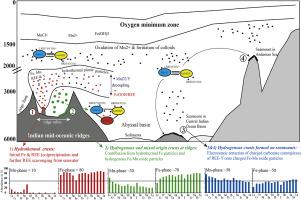当前位置:
X-MOL 学术
›
Chem. Geol.
›
论文详情
Our official English website, www.x-mol.net, welcomes your
feedback! (Note: you will need to create a separate account there.)
Anomalous phase association of REE in ferromanganese crusts from Indian mid-oceanic ridges: Evidence for large scale dispersion of hydrothermal iron
Chemical Geology ( IF 3.6 ) Pub Date : 2020-09-01 , DOI: 10.1016/j.chemgeo.2020.119679 Surya Prakash L. , Durbar Ray , Nagender Nath B. , Satyanarayanan M. , Kamesh Raju K.A. , John P. Kurian , Dileep Kumar M. , Srinivas Rao A.
Chemical Geology ( IF 3.6 ) Pub Date : 2020-09-01 , DOI: 10.1016/j.chemgeo.2020.119679 Surya Prakash L. , Durbar Ray , Nagender Nath B. , Satyanarayanan M. , Kamesh Raju K.A. , John P. Kurian , Dileep Kumar M. , Srinivas Rao A.

|
Abstract Ferromanganese crusts collected at selected locations along the ~7000 km long stretch of Carlsberg, Central Indian and Southwest Indian ridges are studied for bulk geochemical composition and distribution of rare earths and yttrium in major geochemical phases; exchangeable/carbonate, Mn-oxide, Fe-oxyhydroxide and residual silicate. The crusts are dominated by vernadite with traces of quartz and calcite. A high concentrations of major (Fe, Mn), trace (Co, Ni, Cu & Zn) and rare earth elements indicates that these crusts are hydrogenous in nature. However, the negative or no cerium anomalies in the shale normalized REE pattern indicates that some of these crusts are of mixed type (hydrogenous and hydrothermal). Irrespective of their nature (mixed or hydrogenous), the phase distribution of REE-Y shows 70–83% of total REE-Y are associated with Fe-oxyhydroxide phase, whereas only about 17–30% are associated with Mn-oxide phase. Such phase-distribution is expected in mixed type crusts because it is a combination of hydrothermal (where 90% of the total REE-Y is associated with only Fe-oxyhydroxide phase) and hydrogenous processes (where 50% of the total REE-Y is associated with only Fe-oxyhydroxide phase). Conversely, the hydrogenous crusts also shows similar phase-distributions (70–83% association with Fe-oxyhydroxide phase) which is certainly different from typical hydrogenous crusts where both Fe-oxyhydroxide and Mn-oxide phases host equal amounts (50% each). The large scale dispersion of hydrothermal particulate iron along the Indian Ocean ridges is likely to contribute an additional Fe-bound REE-Y pool to these crusts. The positive yttrium anomaly in Mn-oxide phase of all these crusts substantiates the hydrothermal contribution.
中文翻译:

印度洋中脊铁锰结壳中稀土元素的异常相组合:热液铁大规模弥散的证据
摘要 研究了在嘉士伯、中印度和西南印度洋脊约 7000 公里长的选定地点收集的铁锰结壳,研究了主要地球化学相中稀土和钇的整体地球化学组成和分布;可交换/碳酸盐、Mn-氧化物、Fe-羟基氧化物和残余硅酸盐。地壳以绿松石为主,并带有石英和方解石的痕迹。高浓度的主要(Fe、Mn)、痕量(Co、Ni、Cu 和 Zn)和稀土元素表明这些结壳本质上是含氢元素。然而,页岩归一化稀土元素模式中的铈异常或无铈异常表明这些结壳中的一些是混合类型(氢和热液)。无论其性质如何(混合或含氢),REE-Y 的相分布显示 70-83% 的 REE-Y 与 Fe-羟基氧化物相相关,而只有约 17-30% 与 Mn-氧化物相相关。这种相分布在混合型结壳中是预期的,因为它是热液(其中 REE-Y 总量的 90% 仅与 Fe-羟基氧化物相相关)和氢过程(其中 REE-Y 总量的 50% 是仅与 Fe-羟基氧化物相相关)。相反,含氢结壳也显示出相似的相分布(70-83% 与 Fe-羟基氧化物相结合),这肯定不同于典型的含氢结壳,其中 Fe-羟基氧化物和 Mn-氧化物相的含量相等(各 50%)。沿印度洋海脊的热液微粒铁的大规模扩散很可能为这些结壳贡献了额外的铁结合 REE-Y 池。所有这些结壳的氧化锰相中的钇正异常证实了热液的贡献。
更新日期:2020-09-01
中文翻译:

印度洋中脊铁锰结壳中稀土元素的异常相组合:热液铁大规模弥散的证据
摘要 研究了在嘉士伯、中印度和西南印度洋脊约 7000 公里长的选定地点收集的铁锰结壳,研究了主要地球化学相中稀土和钇的整体地球化学组成和分布;可交换/碳酸盐、Mn-氧化物、Fe-羟基氧化物和残余硅酸盐。地壳以绿松石为主,并带有石英和方解石的痕迹。高浓度的主要(Fe、Mn)、痕量(Co、Ni、Cu 和 Zn)和稀土元素表明这些结壳本质上是含氢元素。然而,页岩归一化稀土元素模式中的铈异常或无铈异常表明这些结壳中的一些是混合类型(氢和热液)。无论其性质如何(混合或含氢),REE-Y 的相分布显示 70-83% 的 REE-Y 与 Fe-羟基氧化物相相关,而只有约 17-30% 与 Mn-氧化物相相关。这种相分布在混合型结壳中是预期的,因为它是热液(其中 REE-Y 总量的 90% 仅与 Fe-羟基氧化物相相关)和氢过程(其中 REE-Y 总量的 50% 是仅与 Fe-羟基氧化物相相关)。相反,含氢结壳也显示出相似的相分布(70-83% 与 Fe-羟基氧化物相结合),这肯定不同于典型的含氢结壳,其中 Fe-羟基氧化物和 Mn-氧化物相的含量相等(各 50%)。沿印度洋海脊的热液微粒铁的大规模扩散很可能为这些结壳贡献了额外的铁结合 REE-Y 池。所有这些结壳的氧化锰相中的钇正异常证实了热液的贡献。











































 京公网安备 11010802027423号
京公网安备 11010802027423号